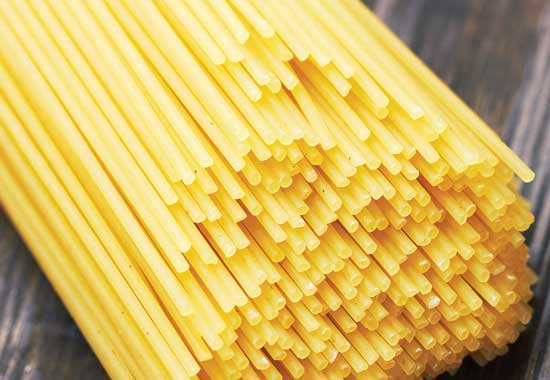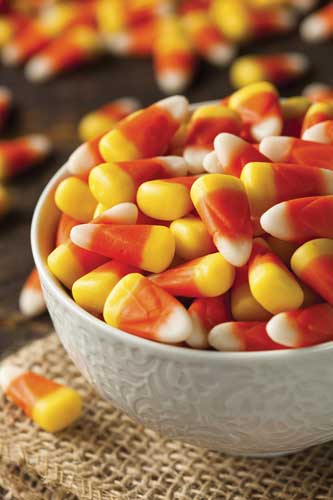Clean label is here to stay; the Chemistry of Halloween candy
NEWS
 Drying conditions impact pasta attributes
Drying conditions impact pasta attributesSpaghetti dried at higher temperatures experienced a greater sauce retention capacity than spaghetti dried at lower temperatures, according to a recent study published in Journal of Food Science.
In the study, “Characterization of Spaghetti Prepared Under Different Drying Conditions,” researchers compared the color, rupture strength, texture, and sauce retention capacity of spaghetti dried at low (max. 50°C), high (max. 70°C), and very high (max. 85°C) temperatures. The surface texture was rougher and rupture strength was higher in spaghetti dried at higher temperatures; color and hardness were not affected. Sauce retention capacity of cooked spaghetti was greater in the samples dried at higher temperatures, which the researchers attribute to the smoother surface of pasta dried at lower temperatures, as well as a higher degree of amylose leakage.
According to the authors, sauce retention plays an important role in determining the palatability of pasta; consumers may enjoy spaghetti more when sauce clings to the noodles. However, according to Shuji Adachi, one of the study’s authors, the attributes that consumers consider most important vary by region and country. Adachi suggests that manufacturers use these findings to create pastas appropriate for the consumers they serve.
Webcast discusses FSMA final ruleOn Sept. 24, IFT held a live webcast centered around the Food Safety Modernization Act (FSMA). In “FSMA Final Rule for Preventive Controls for Human Food,” Jenny Scott, senior adviser to the director of the Office of Food Safety at the Food and Drug Administration’s (FDA) Center for Food Safety and Applied Nutrition, shed light on the final rule recently published by the FDA. This rule requires a food facility to have and implement preventive controls to significantly minimize or prevent the occurrence of hazards that could affect food manufactured, processed, packed, or held by the facility.
Scott highlighted the rule’s requirements and provided resources for obtaining more information about certain components. She explained that Good Manufacturing Practices have been impacted, requiring protection against allergen cross-contact and making some previously nonbinding provision, such as education and training, binding. Individuals must have proper training for their roles, as well as in general food hygiene and safety.
In addition, companies must create and implement a food safety plan, which includes hazard analysis, preventive controls, a supply-chain program, a recall plan, and procedures for monitoring, applying corrective actions, and verifying that the plan is being followed. Verification procedures include annual third-party onsite audits. The plans must be reanalyzed every three years or when conditions increase the risk of a certain hazard. Scott detailed the timeline for compliance, which depends on the type of business.
Afterward, IFT professional member Ruth Petran, vice-president of food safety and public health at Ecolab and a Certified Food Scientist, led a Q&A session. For more information about the final rule and to view the webcast, click here.
Effects of bleaching whey proteins
The choice of bleaching methods applied when manufacturing whey protein isolate (WPI) affects the ingredient’s sensory attributes, according to a recent study that appeared in Journal of Food Science. Bleaching in general also affects the whey protein’s functionality.
Because much of the fluid whey produced in the United States is derived from making cheddar cheese and therefore contains annatto, it must be bleached to remove the color. In the study “Sensory and Functionality Differences of Whey Protein Isolate Bleached by Hydrogen or Benzoyl Peroxide,” researchers examined WPI bleached using either benzoyl peroxide (BP) or hydrogen peroxide (HP), as well as an unbleached control.
The samples were tested to look for flavor and functionality differences between the methods. HP-bleached WPI had higher concentrations of lipid oxidation and sulfur-containing volatile compounds than the BP and unbleached WPI. In addition, it was characterized by high aroma intensity and cardboard, cabbage, and fatty flavors, while BP-bleached WPI was differentiated by low bitter taste. For both processes, soluble protein loss decreased and protein degradation occurred. Overrun and yield stress were not different. The authors conclude that bleaching affects both flavor and functionality of whey proteins.
Clean label is here to stay
Clean label has moved past being a trend and is now the new rule of the game, said LuAnn Williams, director of innovation for Innova Market Insights, during a recent webinar called “Clean Label & Free From: Trends, Insights & Implications.”
According to Williams, all types of clean label and free-from claims are growing, from gluten-free to non-GM to preservative-free. This aligns with recent Mintel data that said 84% of Americans buy free-from foods because they perceive them as less processed and more natural. More and more consumers want to know everything about the ingredients in the food they are eating, says Williams, and are embracing a “clean conscience” approach to their purchasing decisions.
“I do think we are at the point where consumers expect a certain amount of transparency,” she observes. “Companies have to think very hard about what is the appropriate amount of transparency and then find a very good communication partner to develop a strategy.”
To answer these desires, manufacturers should consider maximizing the potential of packaging, using it to relay information such as where seafood was caught and what cows were fed. They might also choose traditional packaging such as glass jars and bottles to communicate the naturalness and simplicity of their products, says Williams.
She cautions, though, that there is a risk to including too much information: “We’ve seen an explosion in the number of claims, logos, labels, and callouts,” she notes. “At some point, it just becomes a confusing mess and doesn’t communicate the benefits at all.”
--- PAGE BREAK ---
 The chemistry of Halloween candy
The chemistry of Halloween candy
Rich Hartel, an IFT professional member and professor of food engineering at the University of Wisconsin–Madison, delved into the chemistry of the candy in our trick-or-treat bags during a Halloween-themed webcast presented by the American Chemical Society.
Hartel explored the way that caramels, jellies and gummies, and candy corn are made. The texture of caramel is influenced by the amount of sugar crystals present: cubed caramels that easily break contain sugar crystals, while soft, stretchy caramels do not. Caramels contain protein, which allows for the Maillard browning that gives them their color, and the structures within caramel help provide yield stress to prevent cold flow. Gummies and jellies, meanwhile, are made with hydrocolloids, which also prevents them from flowing. Technically, a gummy must contain gelatin, a protein derived from collagen, and jellies are made with a variety of other stabilizers. Jelly beans are made with starch, for example, while licorice is made with flour.
Though the recipe for candy corn can vary, it also contains gelatin, and it is made from three components: fondant, a sugar crystal carrier; frappé, which carries air bubbles; and thinning syrup, which creates a pourable consistency. Candy corn’s semisolid structure is made possible because the air bubbles are packed tightly within the candy; the three colored sections are poured separately but quickly so they adhere.
And while it seems as if people either love or hate candy corn, Hartel says, “The nice thing about the candy industry is that there’s something for everyone.”
News Bites
• AAK acquired a 51% share of Kamani, an Indian specialty oils and fats company.
• Amelia Bay recently launched its newly designed, responsive website, which can be viewed at ameliabay.com.
• Archer Daniels Midland Co. will open a 15,700-square-foot flavor creation, application, and customer service facility in Cranbury, N.J. It also opened its new information technology and support center in Erlanger, Ky.
• California Dairies announced that it commissioned a new evaporator at its Visalia, Calif., plant.
• Cargill will convert its ground beef plant in Columbus, Neb., to a cooked meats facility.
• ConAgra Foods announced plans to move its headquarters from Omaha, Neb., to Chicago.
• A hyperbaric high pressure processing machine will be installed at Cornell University. The university also signed an agreement with Ylii to develop a cheese product targeted to Chinese consumers.
• Flavorchem announced it acquired a flavor production facility in Kerepes, Hungary, which will support the production of the company’s liquid, powdered, and spray-dried products.
• FMC announced that it will establish a European regional headquarters and research facility near Copenhagen, Denmark.
• The Innovation Center for U.S. Dairy is accepting nominations for the U.S. Dairy Sustainability Awards. Applications are due Dec. 4. Click here.
• IOI Loders Croklaan recently obtained International Sustainability and Carbon Certification for the company’s shea supply chain.
• Robert L. Joseph and Corey E. Scott were inducted into The Ohio State University’s Food Science and Technology Hall of Distinction.
• The Kellogg Co. acquired Egypt’s leading cereal company, Mass Food Group.
• Leatherhead Food International was acquired by Science Group; the business will operate as Leatherhead Research.
• Mars unveiled a new Global Food Safety Center in China that will research ways to address food safety concerns. It also entered into an agreement to acquire Grupo Turin, a manufacturer of high-quality chocolates in Mexico.
• McDonald’s announced that it will fully transition to cage-free eggs for its nearly 16,000 restaurants in the United States and Canada over the next 10 years.
• Mondelēz International began producing OREOs in Russia.
• Morton Salt is closing down all production and warehouse operations at its Elston Avenue facility in Chicago.
• Nestlé Nespresso inaugurated its new factory in Romont, Switzerland, as part of its plans to expand in North America.
• Pennsylvania State University’s Berkey Creamery celebrated its 150th anniversary in 2015.
• Purdue University created a new lyophilization consortium, LyoHUB, to improve freeze-drying technology to make food, pharmaceuticals, and biotech products safer and more affordable.
• IFT student member Elizabeth Sloffer, a PhD student at the University of Illinois, won a $19,550 Purdue Center for Global Food Security research grant to fund her work in Honduras.
• SGS and Campden BRI formed a partnership to provide specialist food training services to a wider international audience.
• IFTSA President-Elect Matt Teegarden of The Ohio State University was interviewed in a Washington Post article about food ingredients, chemicals, and food safety.
• Al Vega, R&D manager, Nutritional Division, at Watson, led an interactive discussion about antioxidants during SupplySide West.
• Ahmed Yousef from The Ohio State University received a patent for coating compositions for increasing the strength of shell eggs.
 Melanie Zanoza Bartelme,
Melanie Zanoza Bartelme,
Associate Editor
[email protected]
